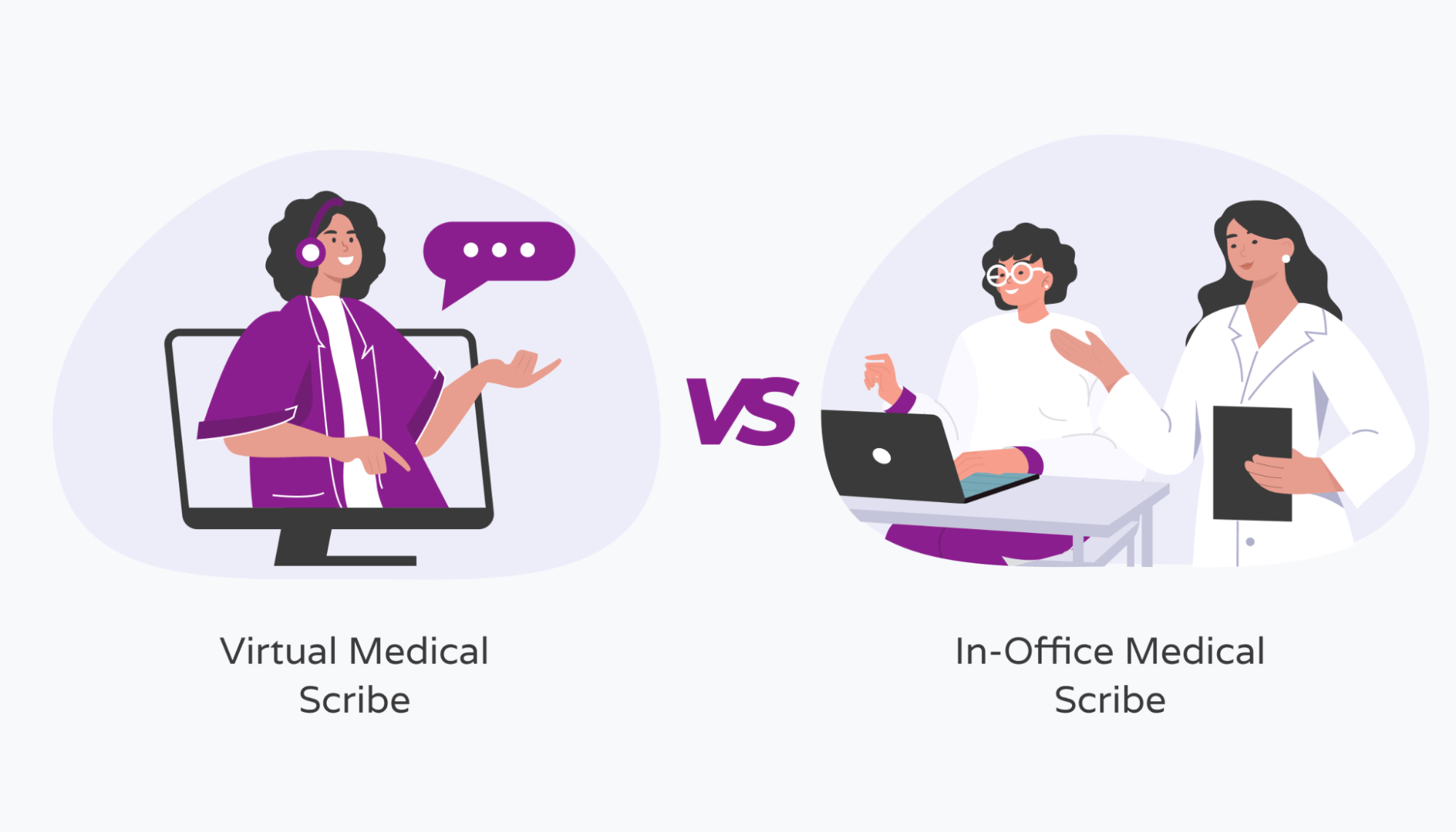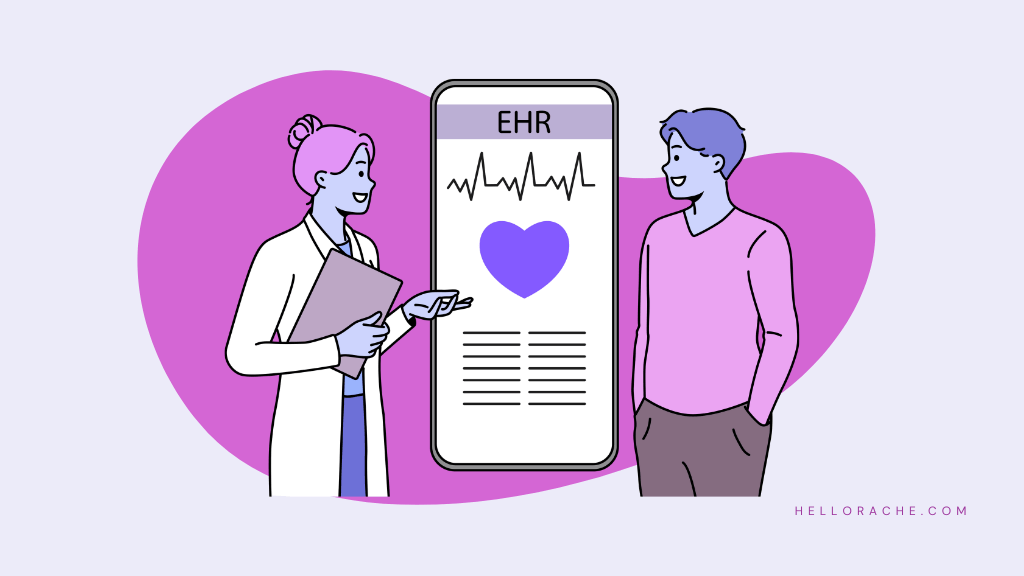Running a physician practice is no easy feat.
From seeing patients and handling administrative tasks to creating clinical documentation, there’s simply too much to do.
Getting a digital scribe or virtual medical scribe will help you save a lot of time and ensure that your patient documentation is up to date and ready to use whenever you need it.
This article will go into depth about what digital scribes and virtual medical scribes are, give you the pros and cons of each, and help you decide which one is the right fit for your practice.
What is a digital scribe?
A digital medical scribe is an artificial intelligence (AI) tool that prepares automatic medical documentation by transcribing patient-centered communication.
It takes over the clinical documentation task currently conducted by humans, using speech recognition and natural language processing to create detailed client reports.
With the use of artificial intelligence increasing by the year, the AI software market is predicted to reach $62 billion in 2022. This means that more people and businesses are making use of AI than ever before.

However, many people are hesitant to trust AI in a healthcare setting since any mistakes can lead to serious consequences.
What is a human scribe?
A human medical scribe is essentially a personal assistant to a physician who transcribes doctor-patient communication and updates patient information in real-time.
Additionally, they make the physician's job easier by preparing all patient information before appointments and making sure that documentation is in order at all times.
They also often have other administrative responsibilities depending on the physician’s needs.
With human medical scribes, you have the option to choose between having an in-office scribe or a virtual scribe.
Virtual scribes are humans who either work independently or at a medical scribe company that outsources them to medical practices virtually.

If you’re interested in experiencing the many benefits of using a virtual medical scribe, why not contact HelloRache today.
Medical scribe responsibilities
Here’s a list of some of the main tasks that scribes — whether human or digital — need to perform.
Transcribe during appointments
Many medical scribes are present throughout patient visits and exams where they need to take notes in real-time.
They’re responsible for gathering patient documentation before the appointment and have to make sure that important communication is recorded so that client information can be updated afterward.
For effective note-taking, they need to use and understand medical terminology to be as clear and accurate as possible.
Update and maintain medical records
Many physician practices rely on electronic health records (EHR) and traditional medical charts.
Thus, medical scribes need to be able to work on a range of software to quickly and accurately update and maintain patient history and other pertinent health information.
Additionally, they need to send all documentation to the physician for review and approval and store the records on the database so that physicians can locate them easily.
Communicate with patients
They’ll sometimes need to communicate with patients after appointments and assist them with any questions they may have.
If they don’t have the answer to a specific question, they can escalate it to the appropriate person in a timely manner to provide clients with exceptional clinical care.
Administrative duties
They’ll often be required to perform other administrative and clerical duties such as answering phone calls and emails, scheduling appointments, making travel arrangements for the physician, ordering supplies, and more.

Learn more about what medical scribes do.
Digital scribe vs. human scribe
Here are some of the key benefits and downsides of hiring both digital and human scribes.
Digital scribe pros and cons
Since a digital scribe is software-based, it’s able to work faster and take notes in less time. It’s also often easy to use, so physicians and other staff members require minimal training to implement digital scribe systems into their workflows.
On the downside, a digital scribe is limited to the type of tasks it can perform. Without proper monitoring, it can also pose a lot of safety risks as malfunctions or errors in transcription can have a severely negative impact on the patient’s well-being.
Human scribe pros and cons
Human scribes can provide additional services aside from transcription and maintenance of patient documentation. They can provide administrative services and exceptional direct patient care — which adds to the overall customer experience.
Additionally, since they’re human, they can also have more meaningful interactions with both patients and staff members creating a better work environment.
The only two downfalls of human scribes is that they work slower and that they may cost more in the long run (when you hire a full-time, office-based medical scribe).
However, when you hire a virtual medical scribe from Hello Rache, your costs are cut drastically as we charge a flat fee of $9.50 per hour for our scribes. There’s no contract or minimum commitment so you only have to pay for what you need. Learn more about our pricing, how it works, and what’s included.
Benefits of hiring a human scribe
Let’s dig a bit deeper into some of the main benefits of hiring a human medical scribe for your practice.
1. Higher employee retention
63% of knowledge workers in the US and 59% in the UK say they’re open to looking for a new job within the next year.

Many employees leave companies due to work conditions and being overworked.
With the help of a medical scribe, you can prevent employee burnout, and consequently, lower your employee turnover rate since many of the repetitive, mundane tasks will be taken care of.
Thus, employees will have more time to focus on and finish their own work — creating a healthy, positive work environment.
2. Happier customers
Having a human medical scribe who can interact with patients and answer their queries will lead to better customer experiences and higher patient satisfaction and loyalty.
Scribes will also be able to empathize with patients and offer support to them whenever necessary.
3. Better workflow
Since scribes are present through many patient visits, taking clinical notes, and updating documentation, physicians can move to the next patient seamlessly without having to worry about doing these tasks themselves. As a result, their workflow will improve, and they’ll have more time to spend with each patient.
4. Increased revenue
With better customer service, a better workflow, and higher brand authority, your practice will be able to attract more clients — which will result in increased revenue.
This leaves you with more money to invest in the growth of your business so that it can achieve new levels of success.
Discover more ways a virtual medical scribe can help your business.
Skills to look for when hiring a human scribe
If you’re considering going the human scribe route, here are a few skills to look out for when hiring one.
Listening skills
To be able to accurately transcribe information, your scribe will need exceptional listening skills.
In addition to their listening skills, knowing the necessary medical terminology will also come in handy as they’ll be able to interpret information more accurately during doctor-patient communication.
Typing skills
Being able to type fast is a must-have for a scribe as they’ll need to type out numerous paragraphs and sometimes even multiple-page documents in one sitting. Most transcriptionists can type at a speed of over 50 words a minute.

Fast typing skills aren't enough, though. They also need to have good grammar and spelling skills to make sure that patient documentation is professional and neat at all times.
Administrative skills
They need to have experience performing certain administrative duties, such as answering phone calls and emails, helping with appointment scheduling, etc.
As such, they need to be familiar with computer systems and different types of software, such as Gmail, Google Calendar, databases, and more.
Customer service
Last but not least, they need to have great people skills so that they can offer exceptional customer service at all times. They need to be willing to go out of their way to help your clients with all of their questions and give them the best possible care.
Ready to hire a medical scribe for your practice?
Whether you choose to hire a digital or human scribe depends on your practice and its needs. If you’re solely looking for a notetaker that can transcribe during appointments, then a digital scribe might be a good option.
On the other hand, if you’re looking for a more hands-on medical scribe that can help with additional tasks such as admin and customer care, then a human scribe is ideal.




